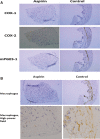Evidence that acetylsalicylic acid attenuates inflammation in the walls of human cerebral aneurysms: preliminary results
- PMID: 23525414
- PMCID: PMC3603234
- DOI: 10.1161/JAHA.112.000019
Evidence that acetylsalicylic acid attenuates inflammation in the walls of human cerebral aneurysms: preliminary results
Abstract
Background: Inflammatory cells and molecules may play a critical role in formation and rupture of cerebral aneurysms. Recently, an epidemiologic study reported that acetylsalicylic acid (ASA) decreases the risk of aneurysm rupture. The goal of this study was to determine the effects of ASA on inflammatory cells and molecules in the walls of human cerebral aneurysms, using radiographic and histological techniques.
Methods and results: Eleven prospectively enrolled patients harboring unruptured intracranial aneurysms were randomized into an ASA-treated (81 mg daily) group (n=6) and an untreated (control) group (n=5). Aneurysms were imaged at baseline using ferumoxytol-enhanced MRI to estimate uptake by macrophages. After 3 months, patients were reimaged before undergoing microsurgical clipping. Aneurysm tissues were collected for immunostaining with monoclonal antibodies for cyclooxygenase-1 (COX-1), cyclooxygenase-2 (COX-2), microsomal prostaglandin E2 synthase-1 (mPGES-1), and macrophages. A decrease in signal intensity on ferumoxytol-enhanced MRI was observed after 3 months of ASA treatment. Expression of COX-2 (but not COX-1), mPGES-1, and macrophages was lower in the ASA group than in the control group.
Conclusions: This study provides preliminary radiographical and histological evidence that ASA may attenuate the inflammatory process in the walls of human cerebral aneurysms.
Clinical trial registration: URL: http://www.clinicaltrials.gov. Unique identifier: NCT01710072.
Figures



References
-
- Aoki T, Kataoka H, Ishibashi R, Nozaki K, Egashira K, Hashimoto N. Impact of monocyte chemoattractant protein‐1 deficiency on cerebral aneurysm formation. Stroke. 2009; 40:942-951 - PubMed
-
- Aoki T, Kataoka H, Shimamura M, Nakagami H, Wakayama K, Moriwaki T, Ishibashi R, Nozaki K, Morishita R, Hashimoto N. NF‐kappaB is a key mediator of cerebral aneurysm formation. Circulation. 2007; 116:2830-2840 - PubMed
-
- Aoki T, Nishimura M, Matsuoka T, Yamamoto K, Furuyashiki T, Kataoka H, Kitaoka S, Ishibashi R, Ishibazawa A, Miyamoto S, Morishita R, Ando J, Hashimoto N, Nozaki K, Narumiya S. PGE(2) ‐EP(2) signalling in endothelium is activated by haemodynamic stress and induces cerebral aneurysm through an amplifying loop via NF‐kappaB. Br J Pharmacol. 2011; 163:1237-1249 - PMC - PubMed
-
- Bruno G, Todor R, Lewis I, Chyatte D. Vascular extracellular matrix remodeling in cerebral aneurysms. J Neurosurg. 1998; 89:431-440 - PubMed
Publication types
MeSH terms
Substances
Associated data
Grants and funding
LinkOut - more resources
Full Text Sources
Other Literature Sources
Medical
Research Materials

